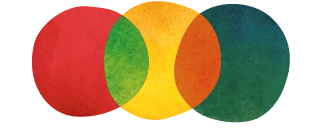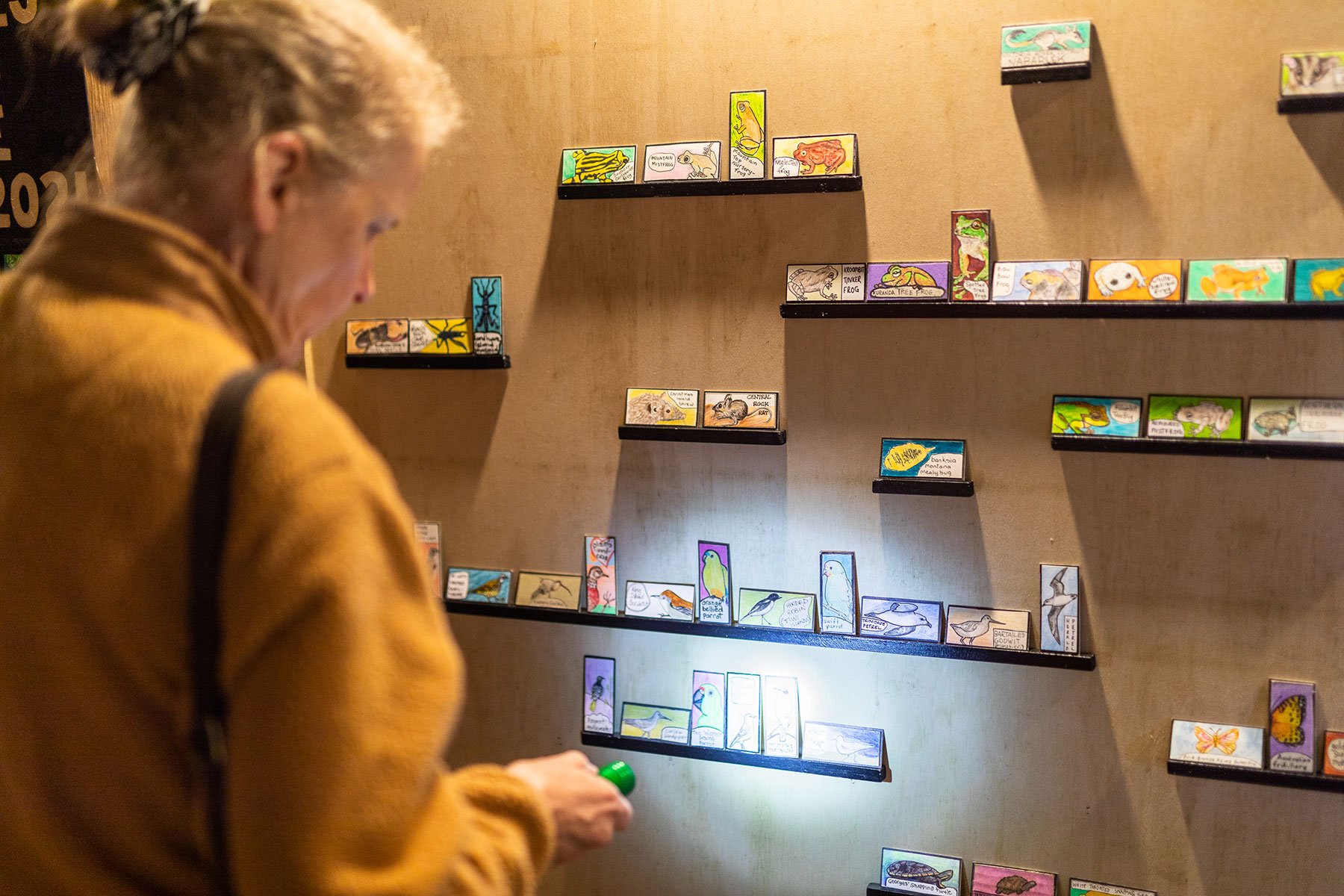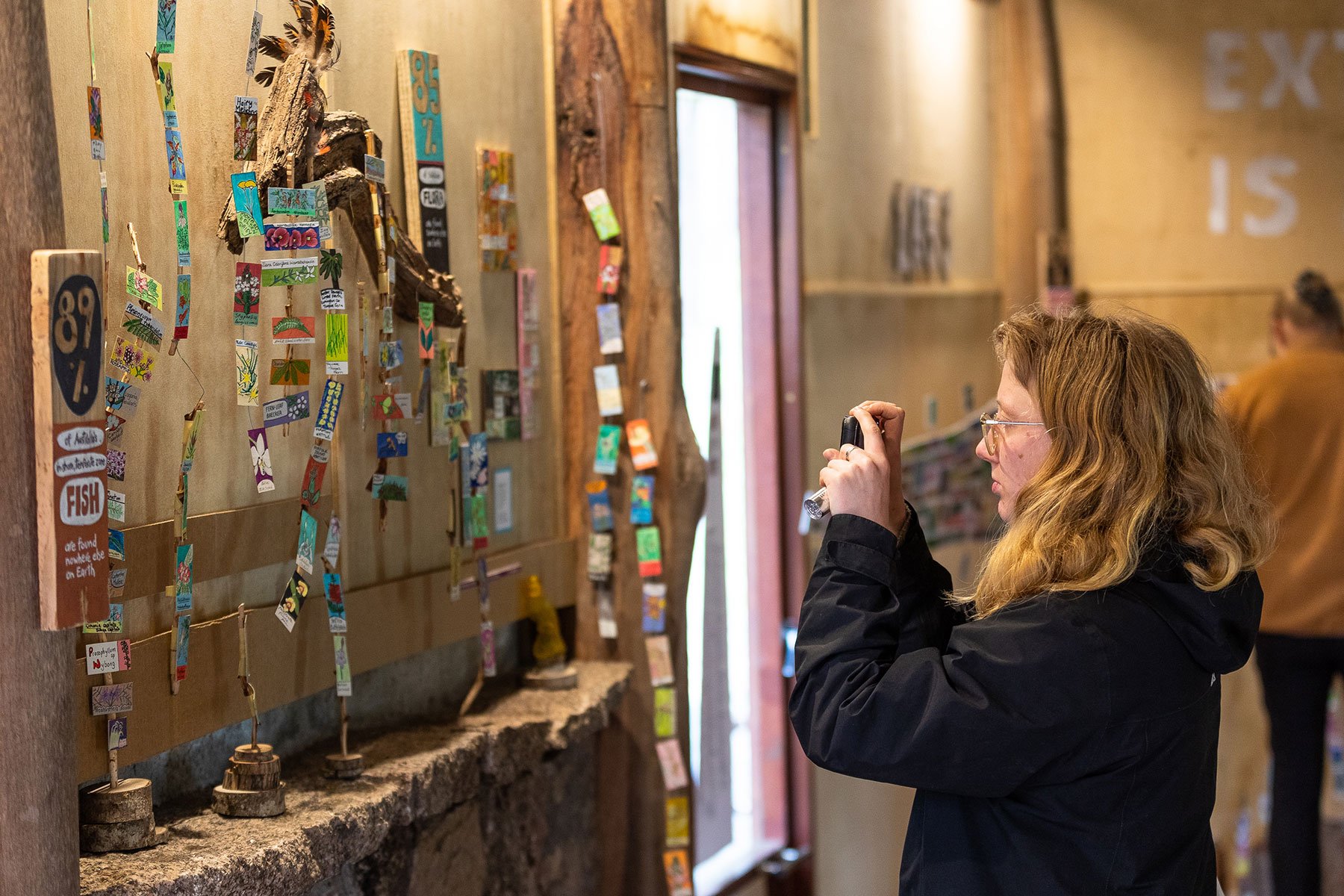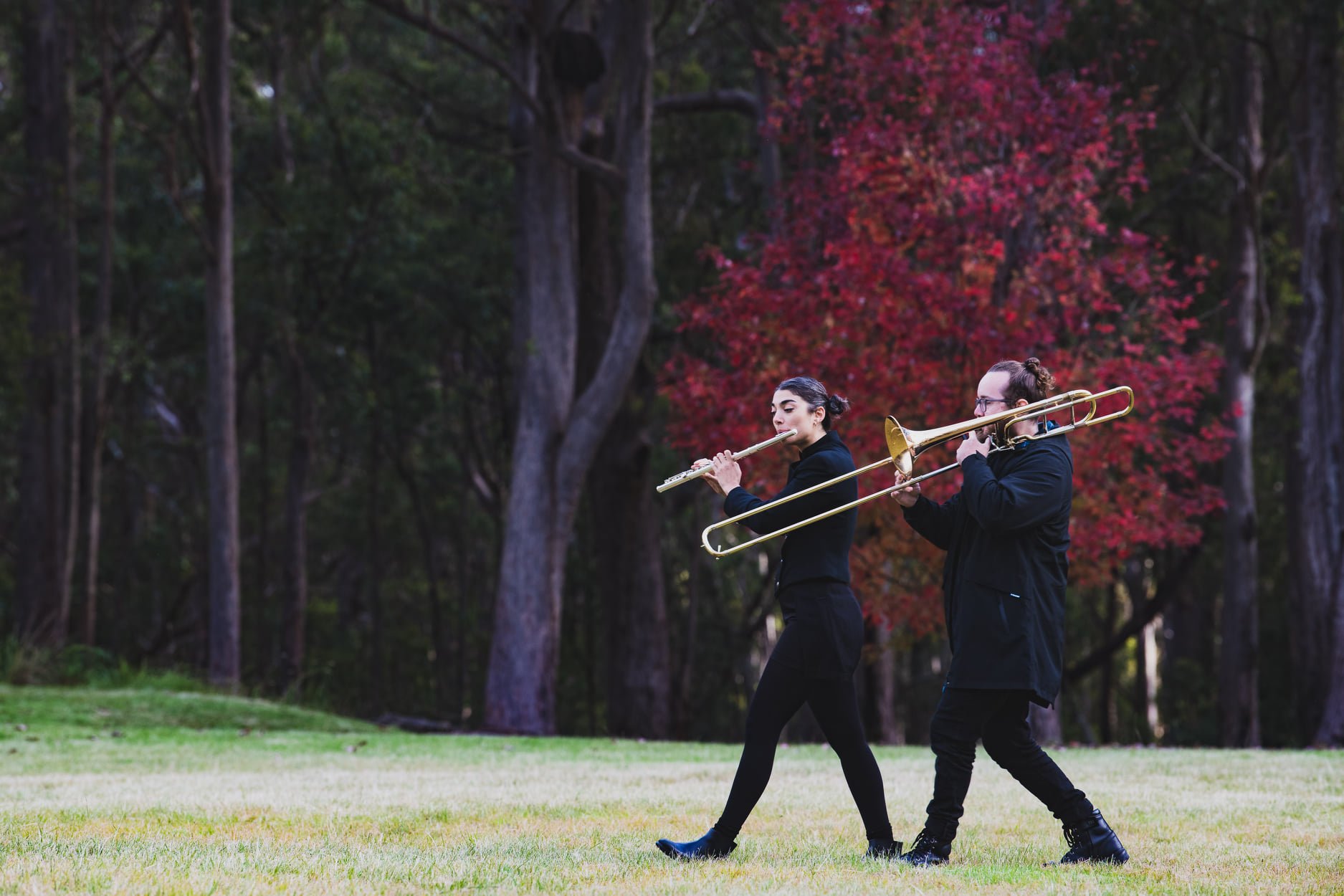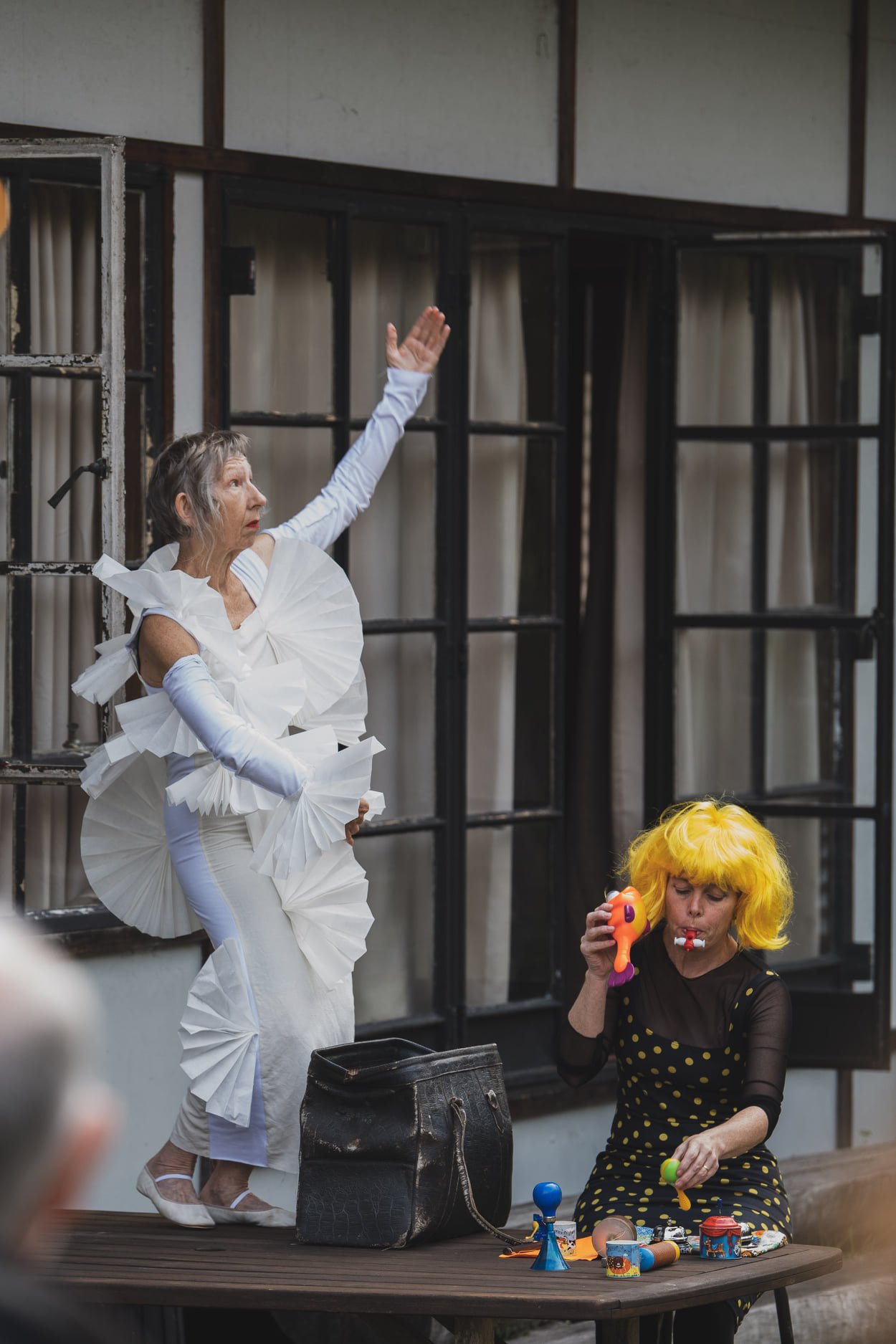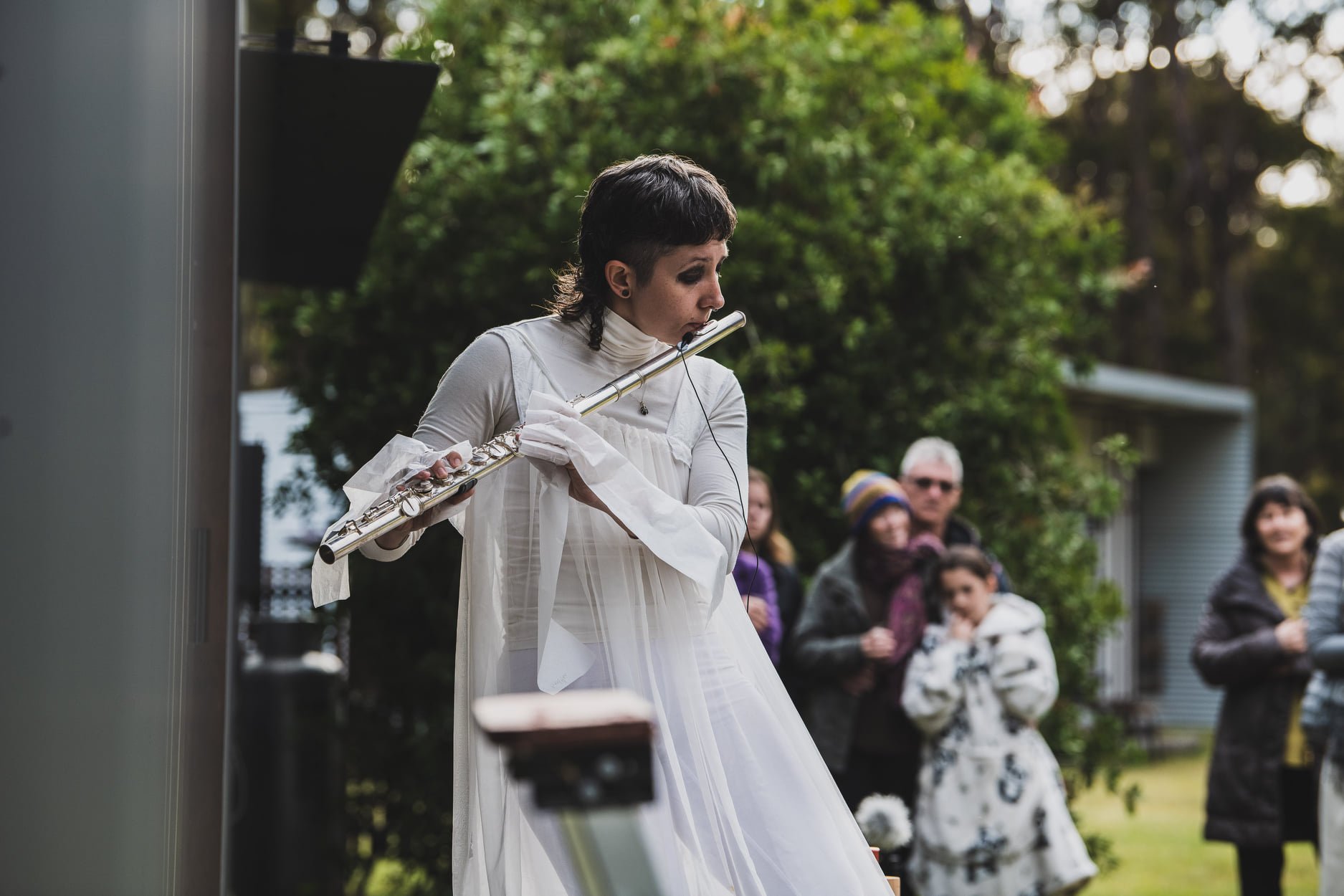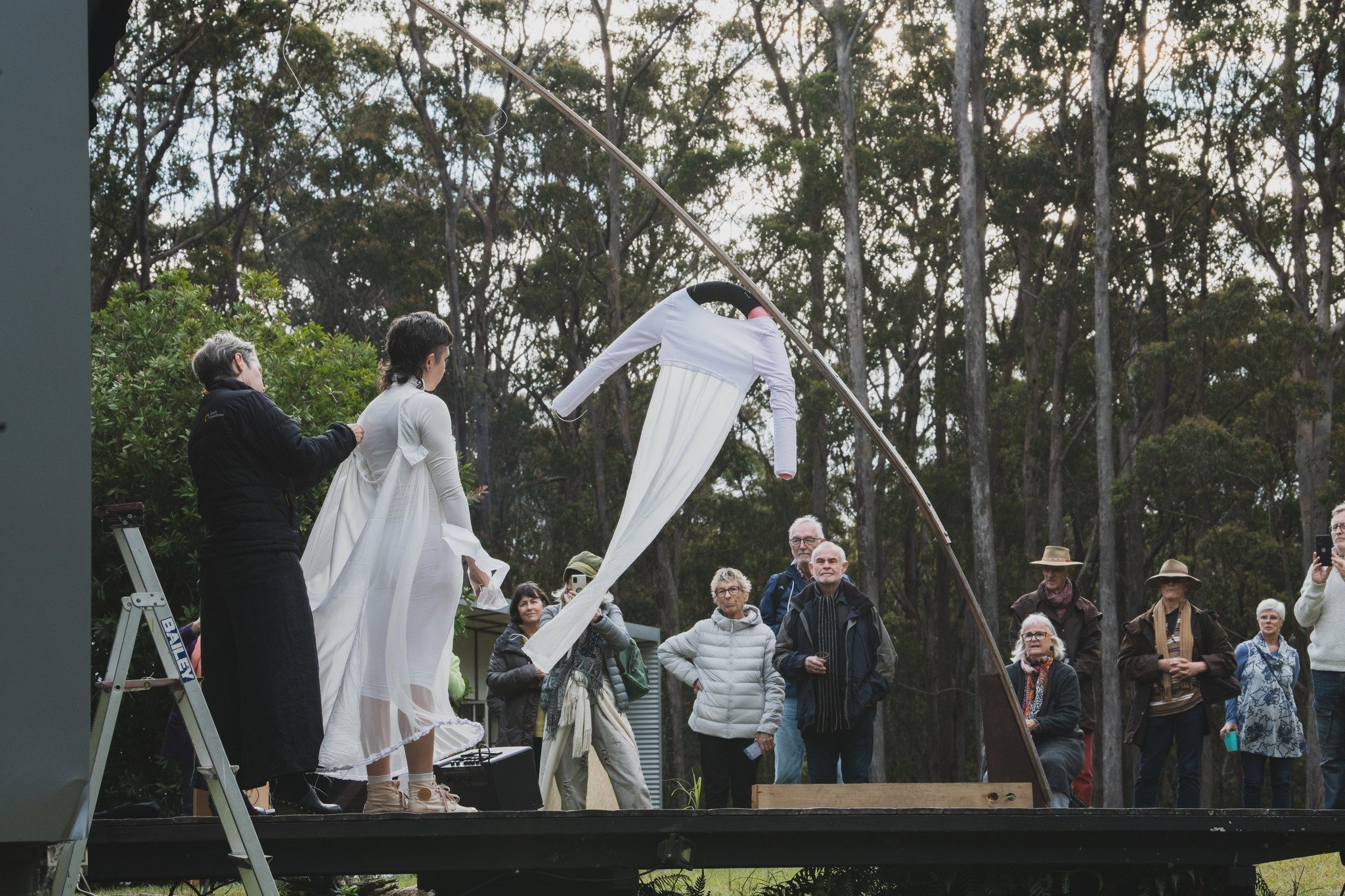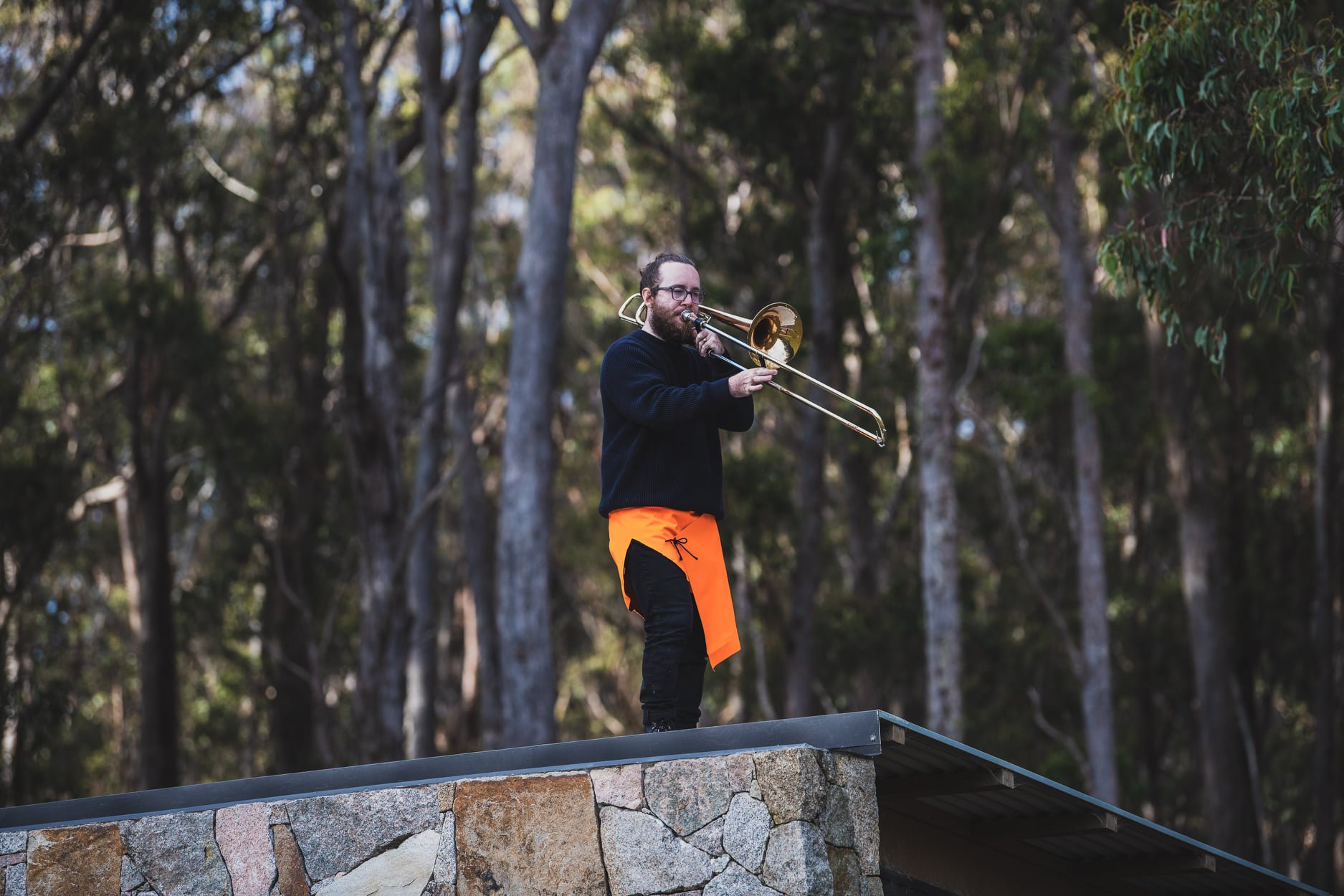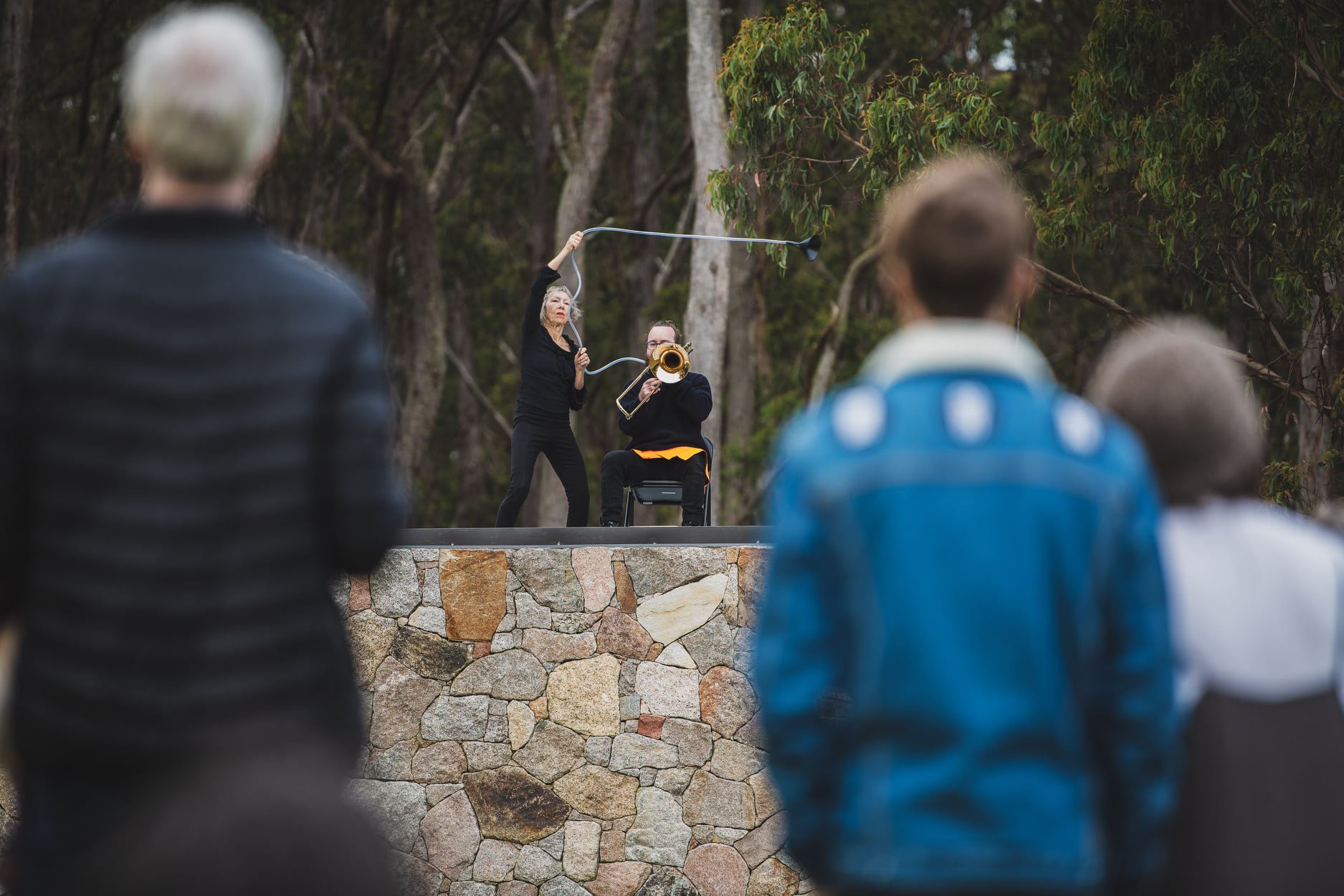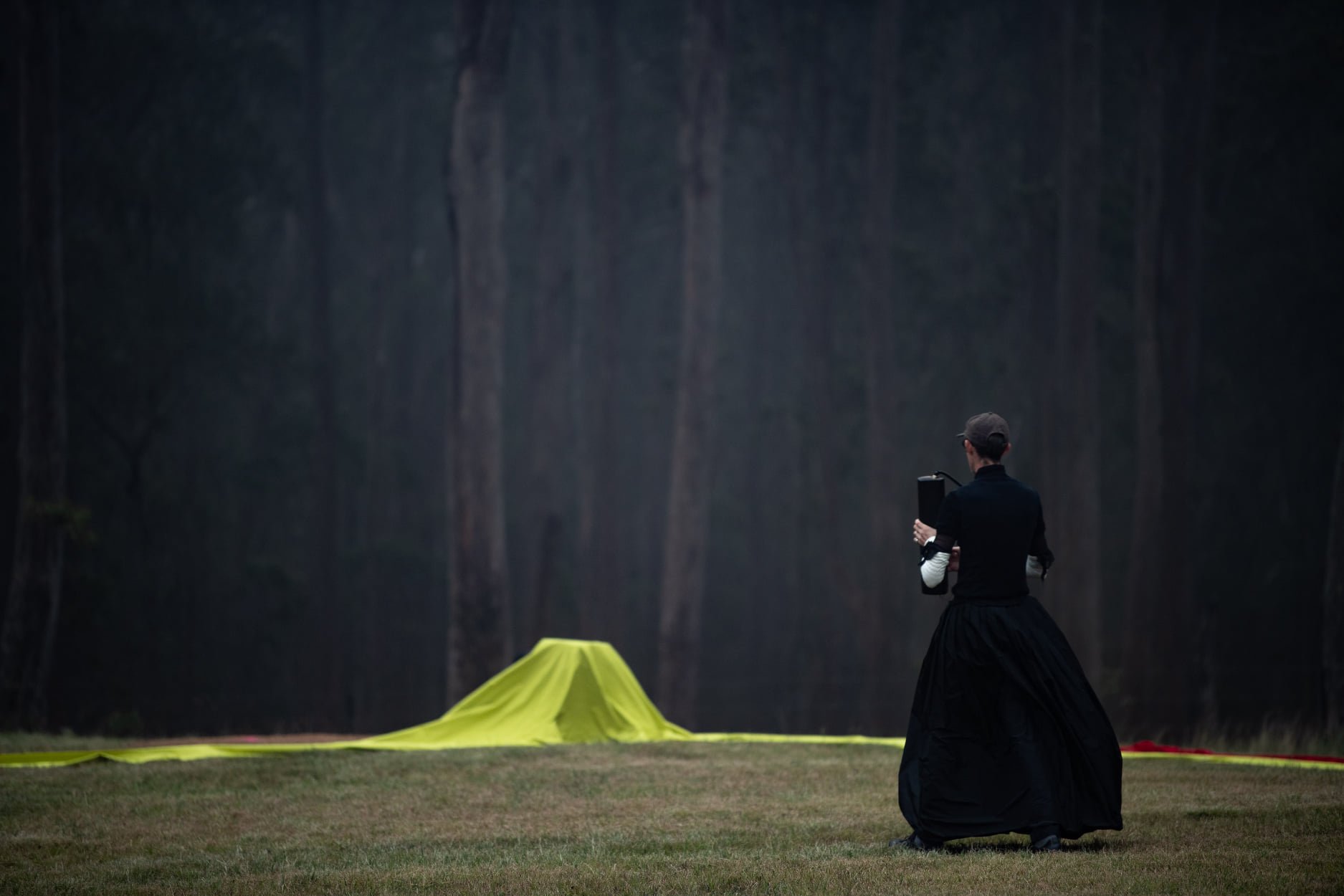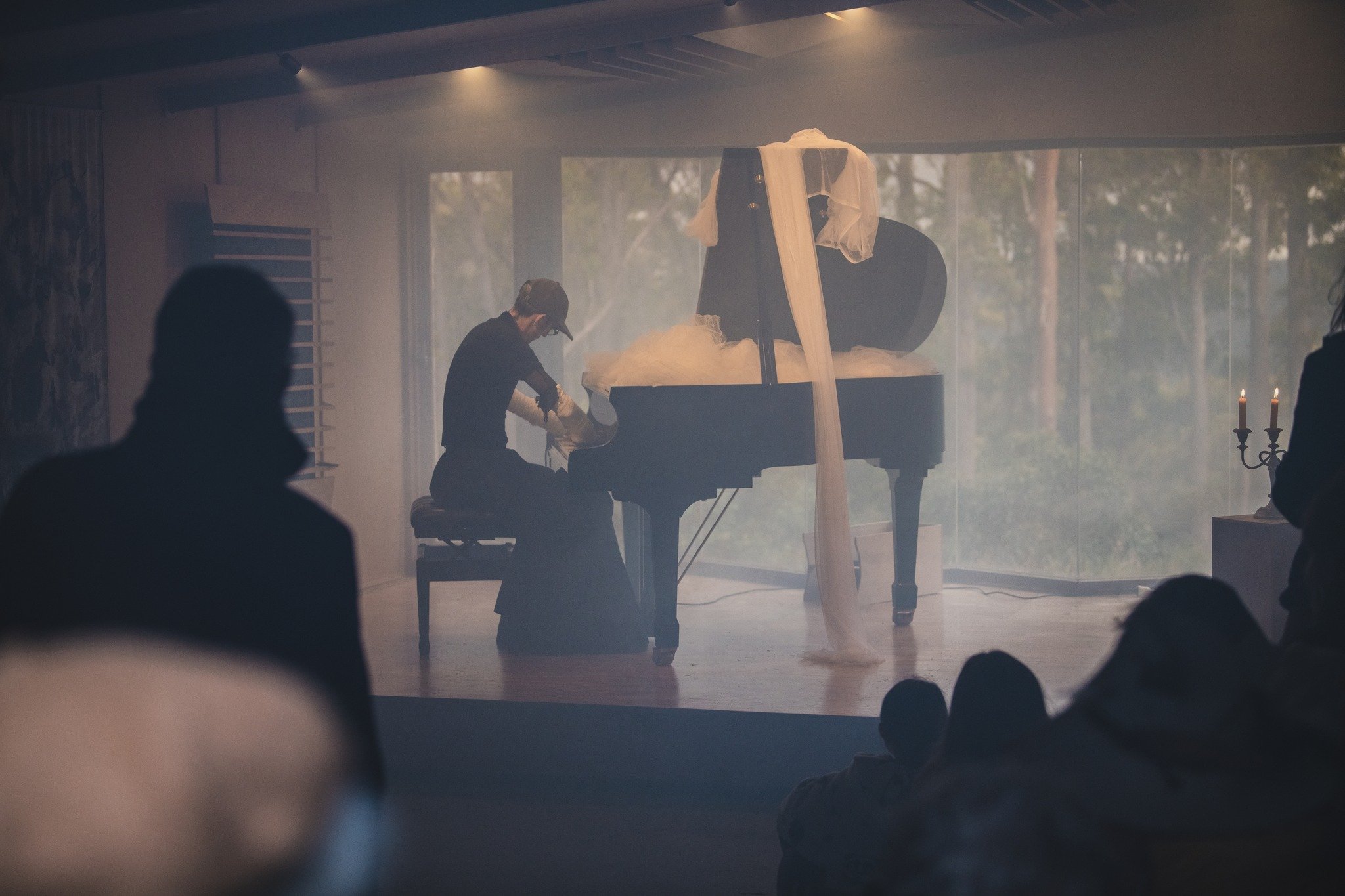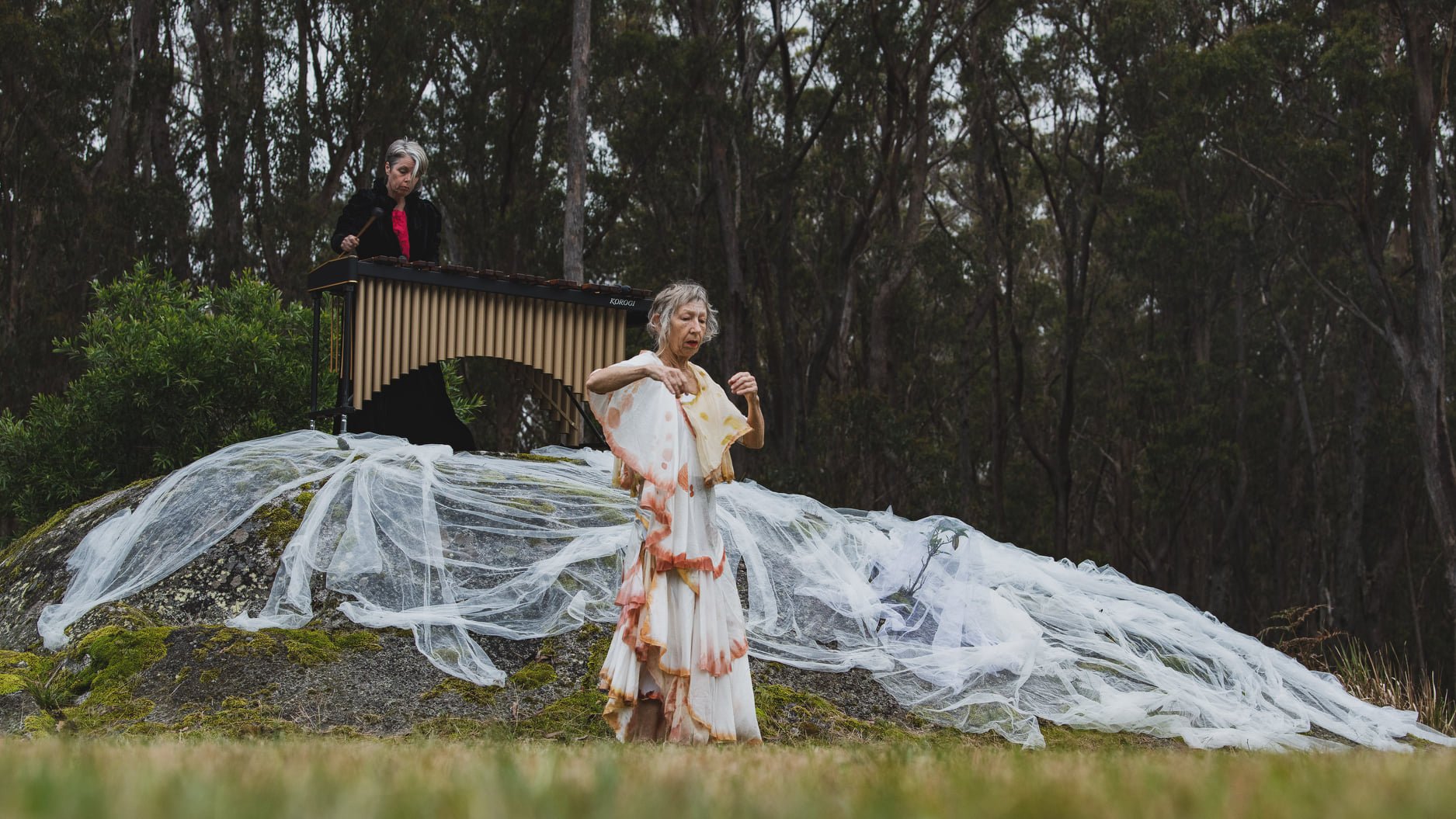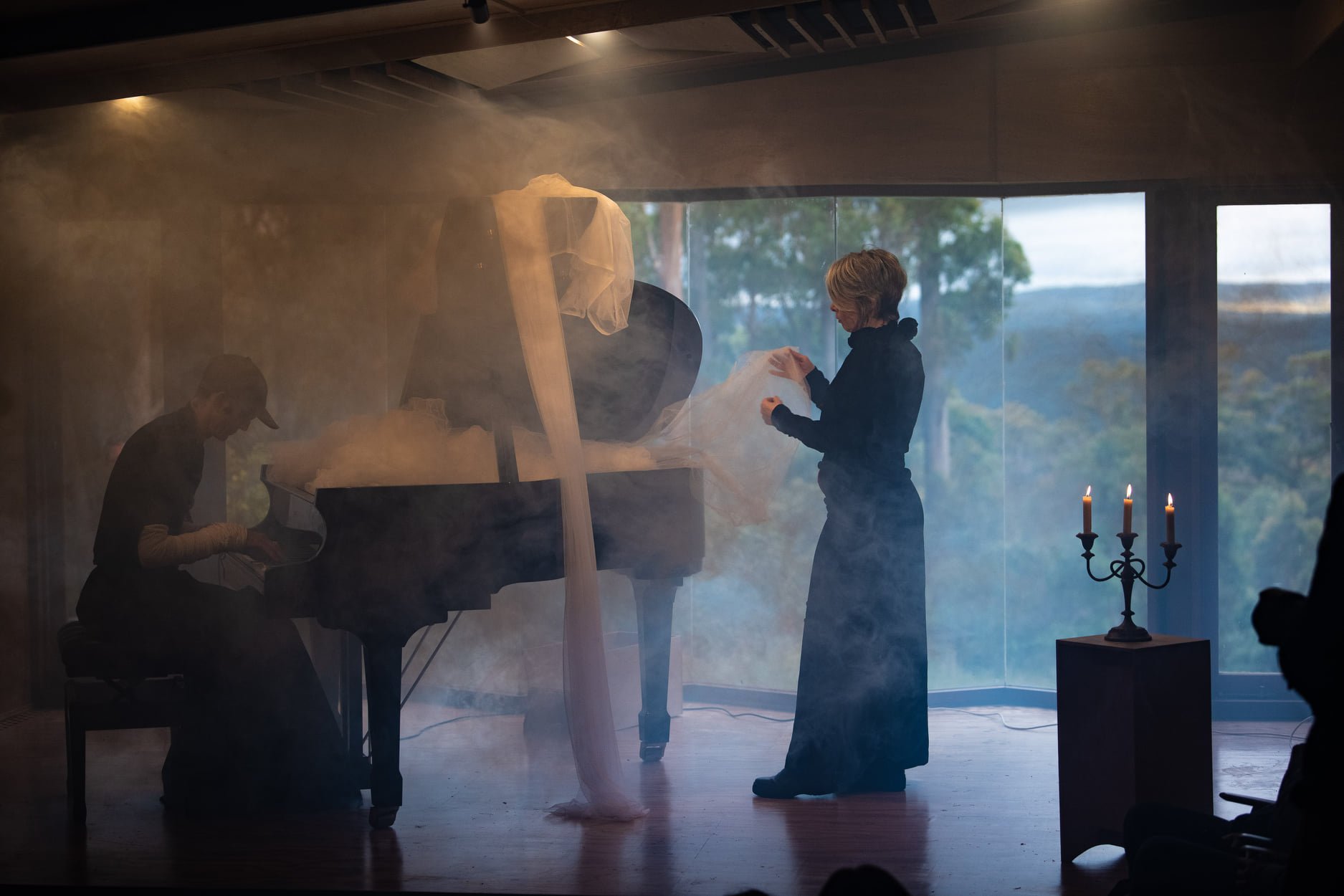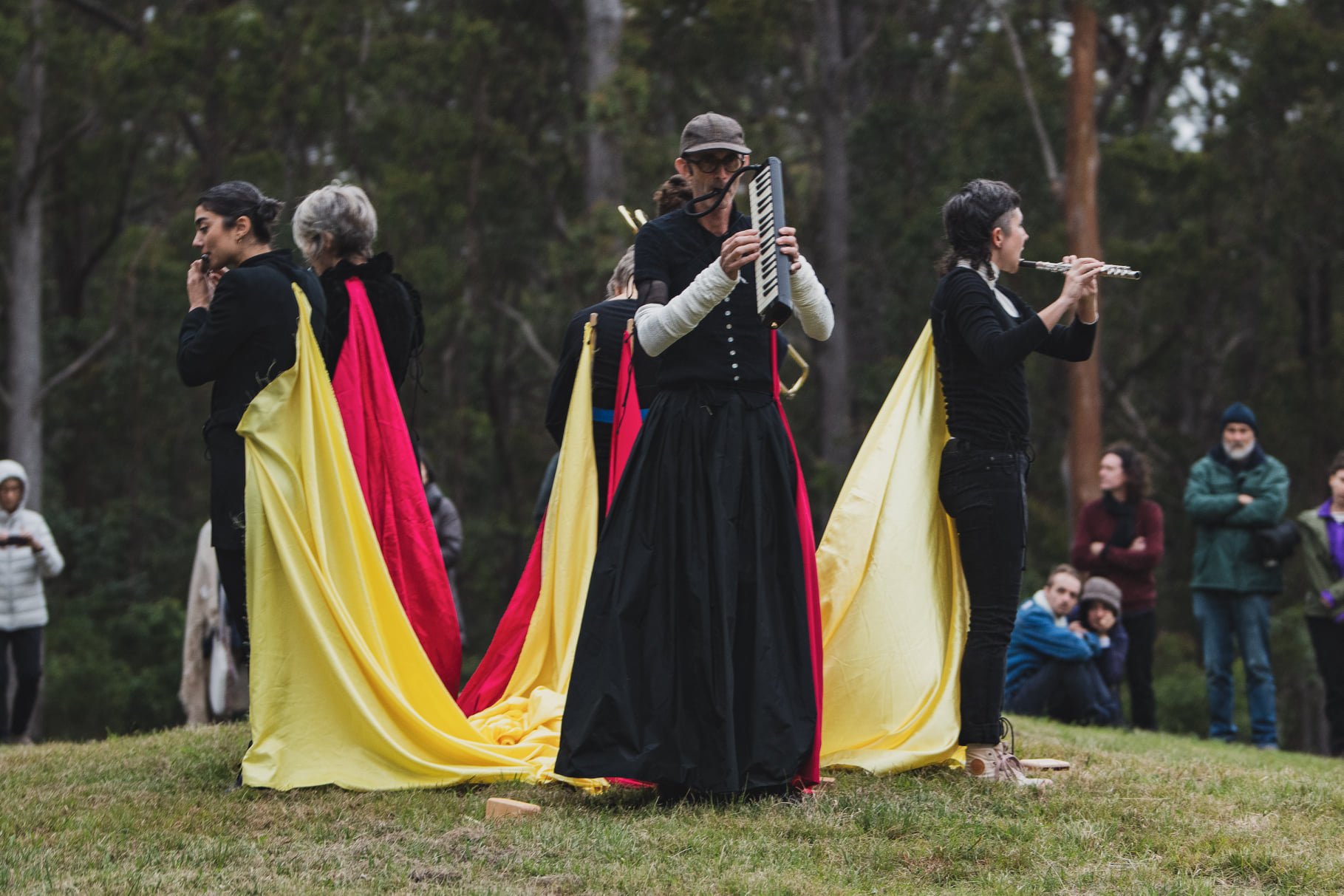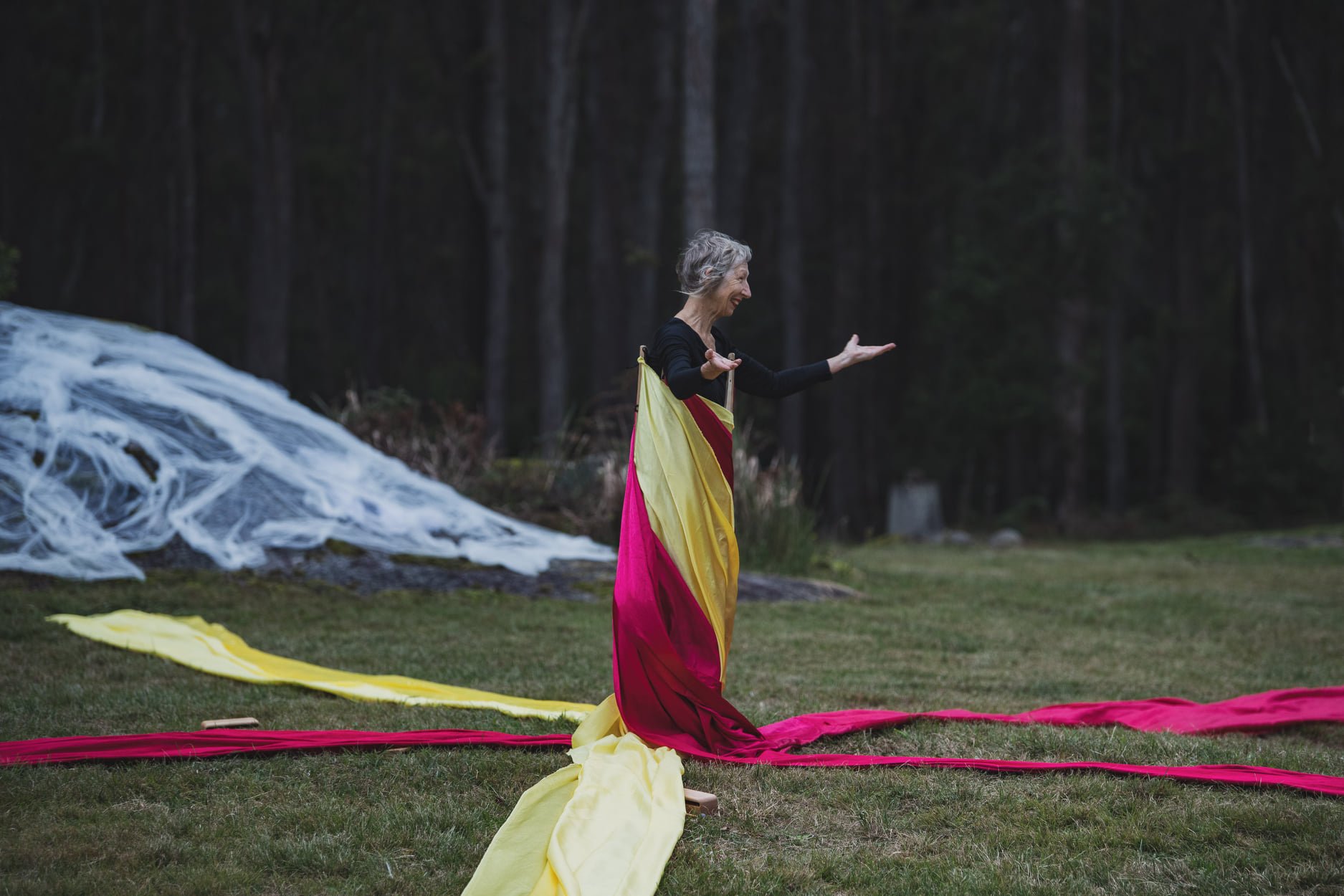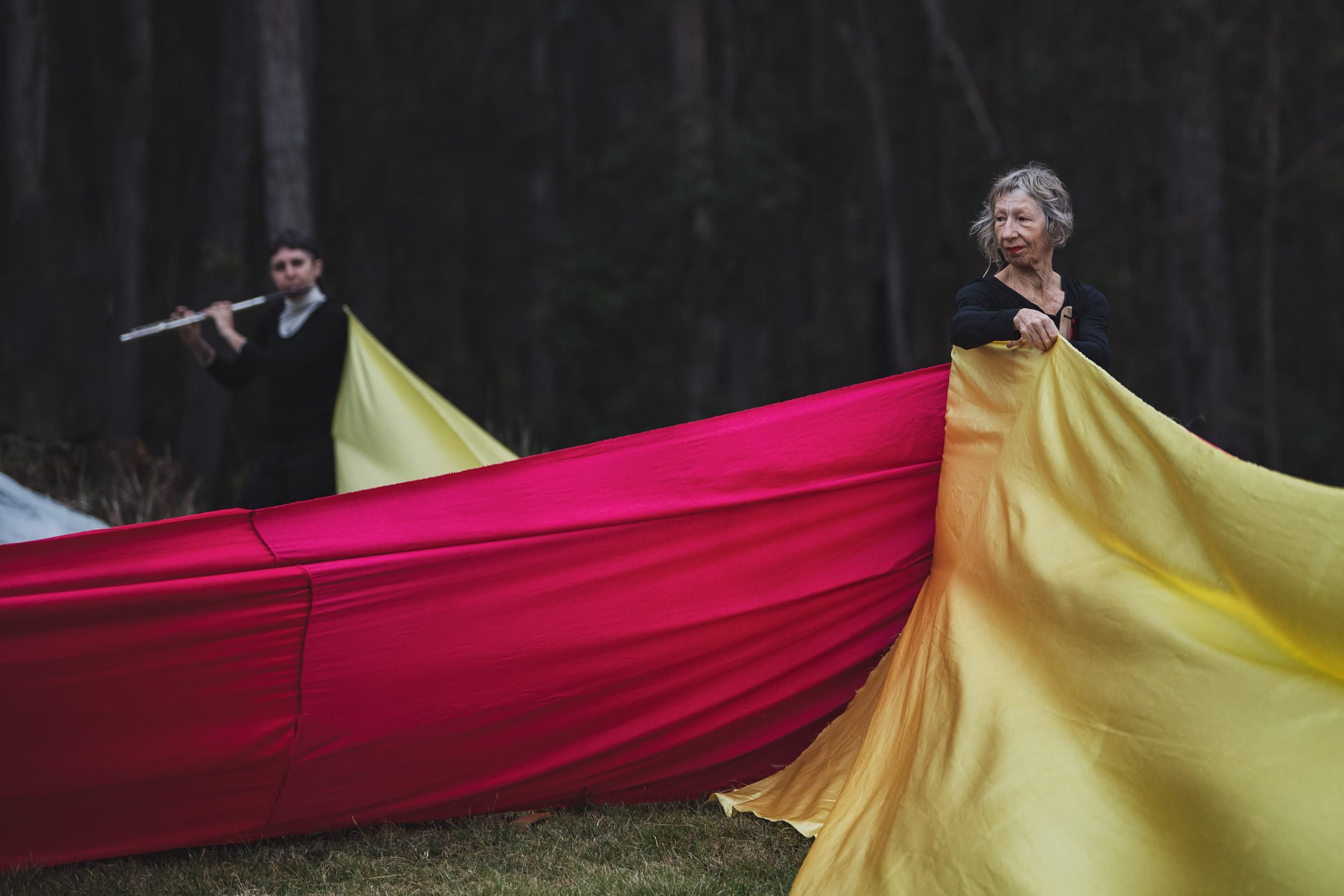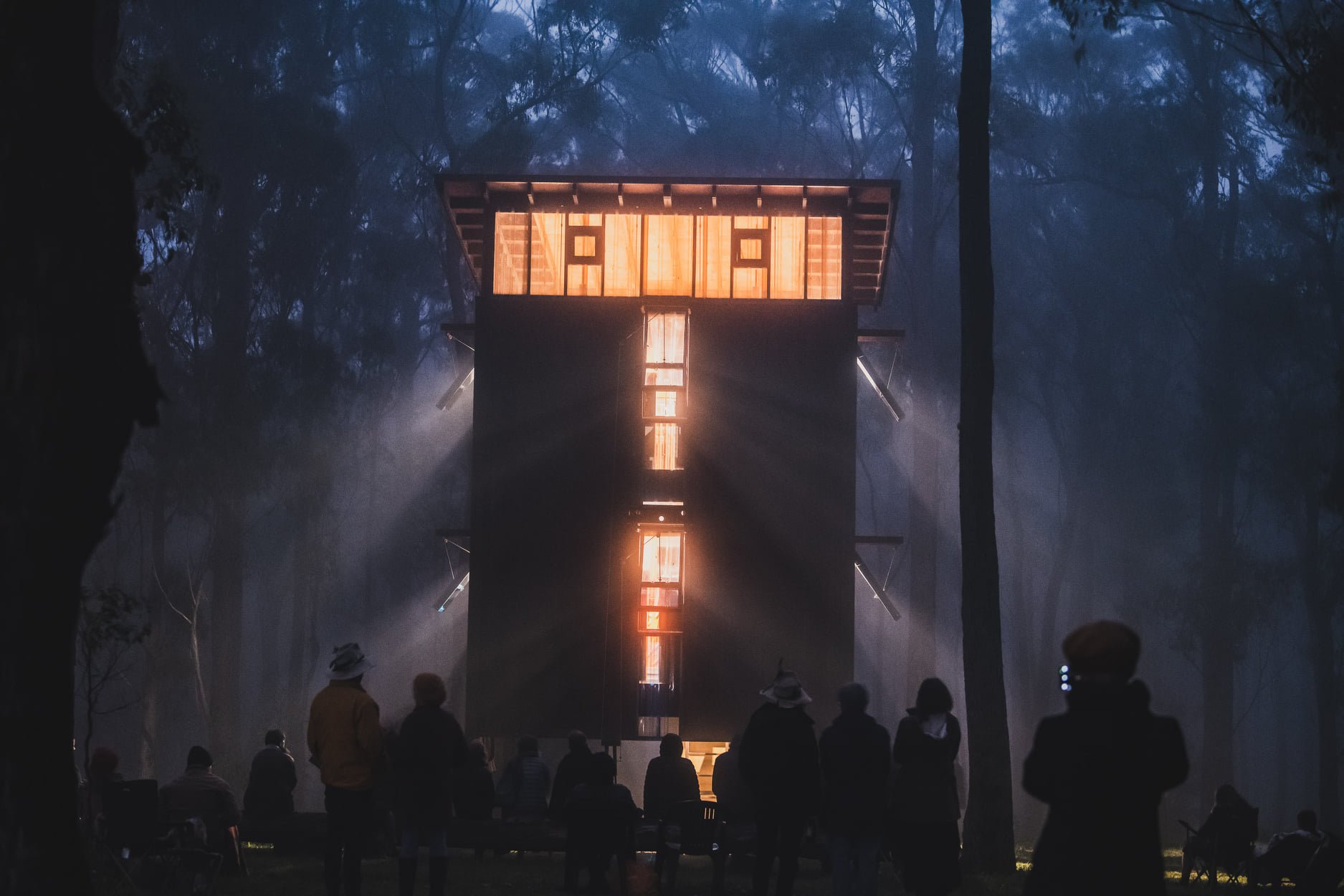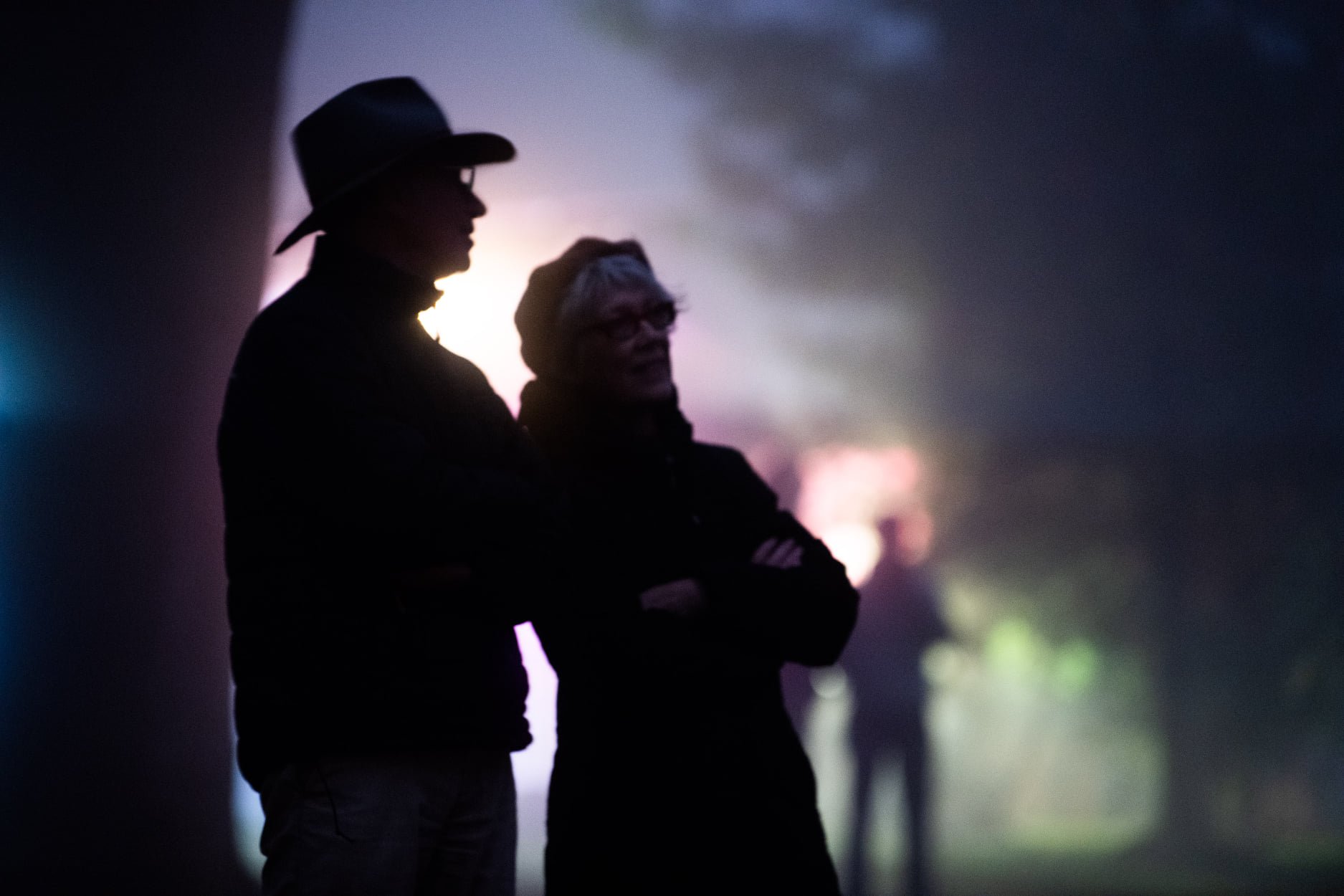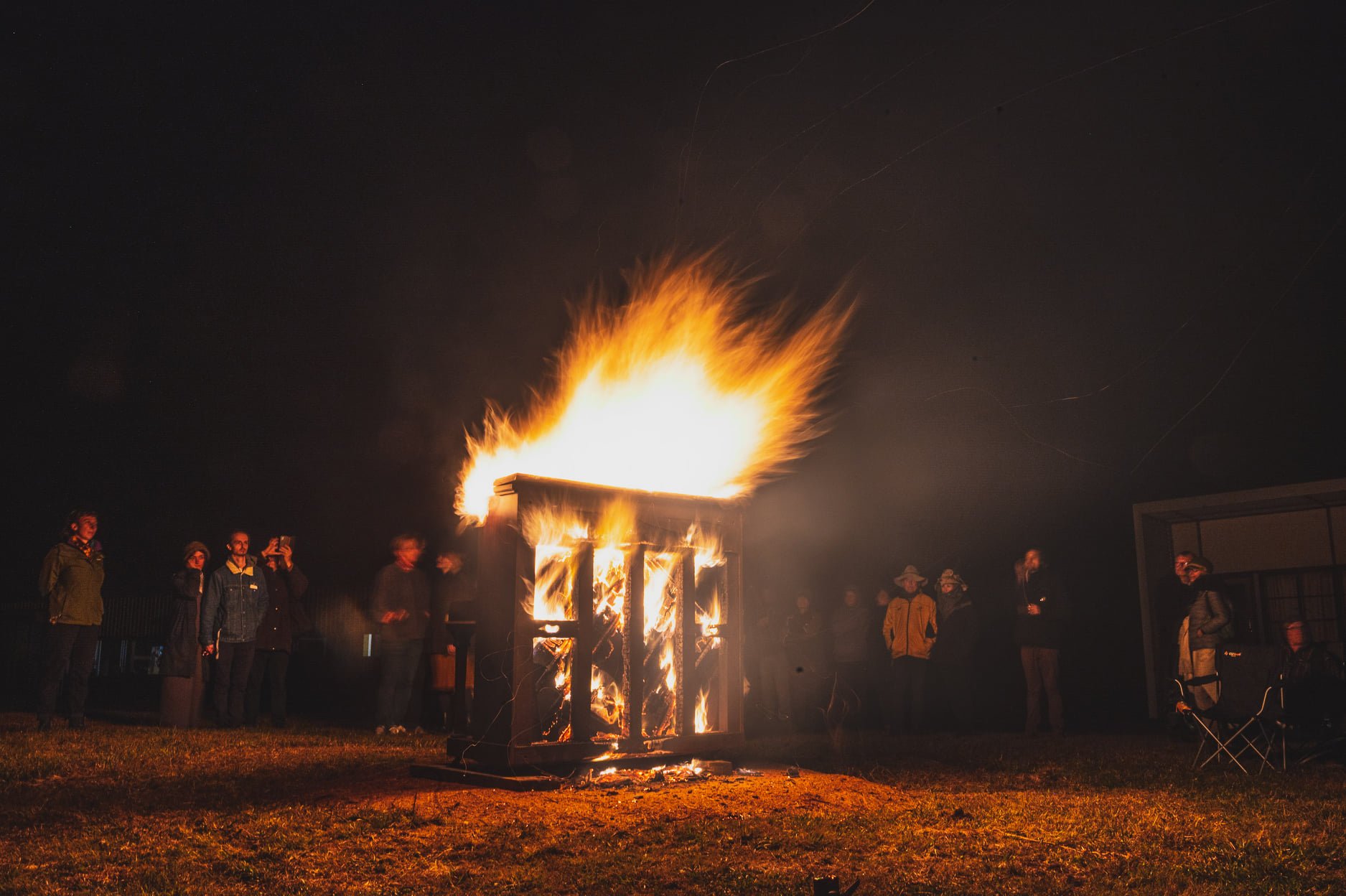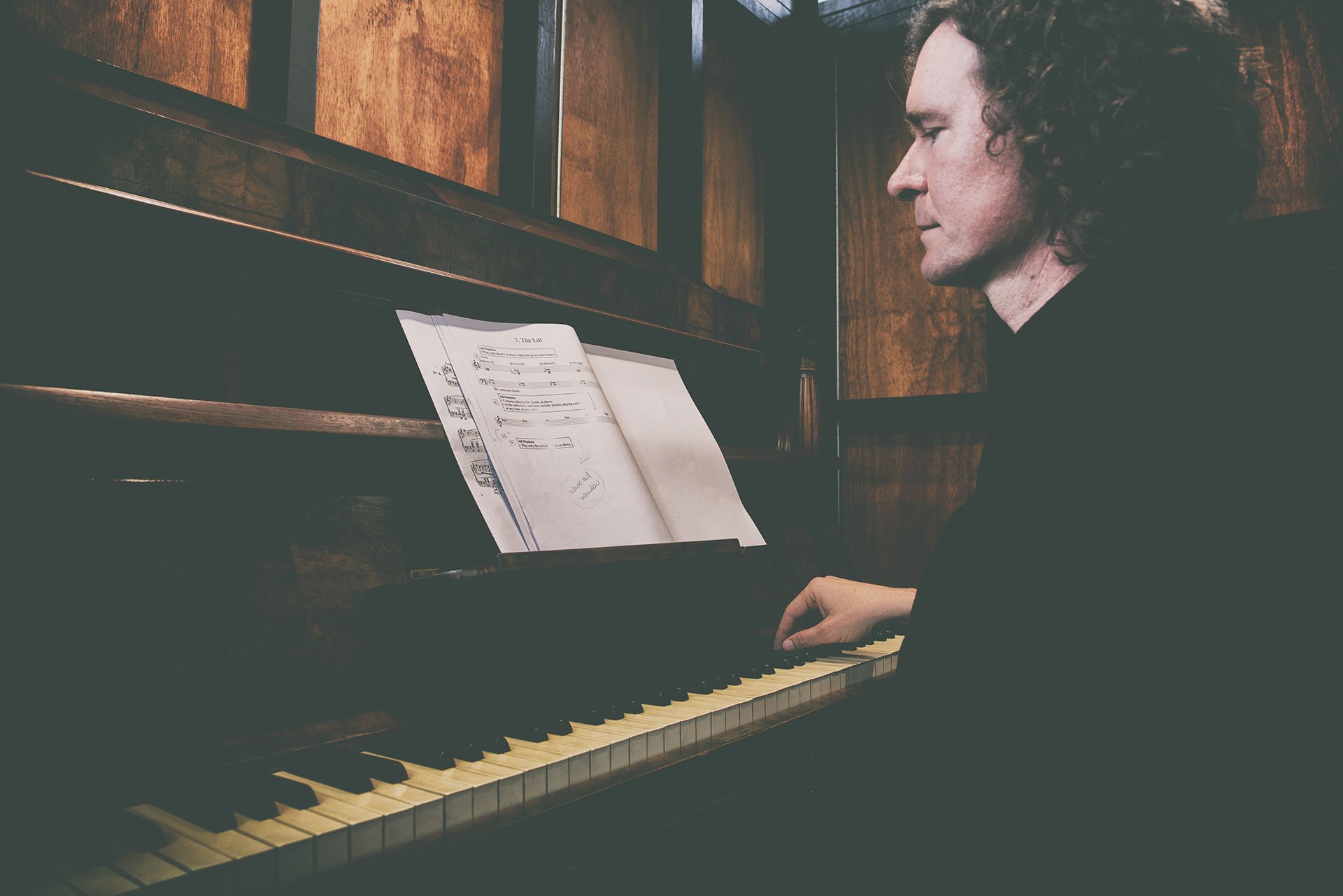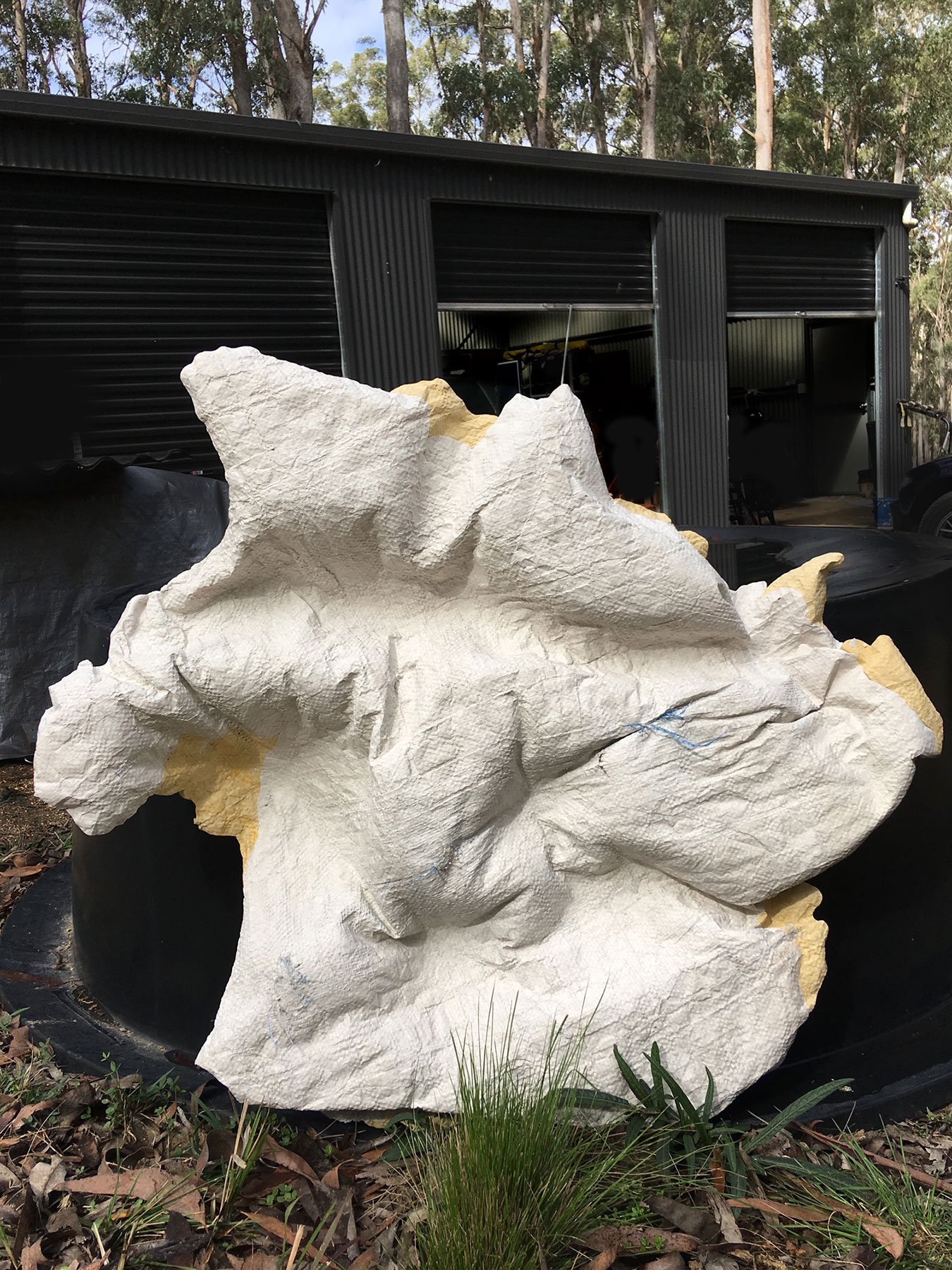Associate Artists
Residency program
Harrigans Lane Collective is offering 3 artist-in-residence places in 2025. We welcome enthusiastic, curious, and adventurous people with a passion for Place-inspired investigation into making, composing, and/or studying in the unique environment that our property and its facilities provides. This residency program is open to individuals or collaborations in small groups of 2 or 3 who wish to draw inspiration from this unique environment and utilise buildings and facilities to enable their work and further their creative practice. We require a proposal of 250 words (or fewer) that outlines the intention of the work to be done during the residency and how it aligns with the HLC mission. Proposals will be assessed by the HLC creative team, including Vanessa Tomlinson and Erik Griswold (Clocked Out), Music & Performing Arts; Bruce Reynolds, Sculpture & Visual Arts; Bruce Wolfe, Design & Making; Jocelyn Wolfe, Research & Administration.
Residency dates 2025
Autumn Residency March 17 – 23
Spring Residency A September 22 – 28
Spring Residency B October 20 – 26
Deadlines
The deadline for proposals for all the 2025 residencies is October 18, 2024
Outcomes will be advised by November 1, 2024.
Queries may be emailed to jocelyn@harriganslanecollective.com.au
Please note there will be an out-of-office period from November 6 to November 26.
Associate Artists
Gabriella Smart and Cat Hope
Gabriella Smart: pianist/improviser, Cat Hope: composer, Jenny Hector: designer (absent)
Artists-in-Residence Spring 2024
Composer Cat Hope and pianist and improviser Gabriella Smart undertook a creative development residency at Harrigans Lane to progress their interdisciplinary work CIVIL - NAUTICAL – ASTRONOMICAL (C-N-A). Informed and inspired by the three stages of evening twilight, Cat and Gabriella brought together music performance and composition to refine the score for this unique 120-minute light responsive work. Unfortunately, circumstances prevented Jenny from joining the residency.
The process for how the work would take shape without Jenny began with bush walks and conversations. Cat and Gabriella were the first residents to use the newly installed 1912 Steinway grand piano in “Lagavulin”, the chamber music concert space. With the piano positioned on the stage in front of the southern facing window, the vista of the twilight sky in the wilderness influenced the score. Each of the three twilight phases are defined by the solar elevation angle, which is the position of the Sun in relation to the horizon.
The scoring possibilities were developed over several days of experimenting during the twilight phase of Nautical. During Nautical twilight, the geometric centre of the Sun's disk is between 6 and 12 degrees below the horizon. The term Nautical is used as, in clear weather conditions, the horizon is faintly visible and the brighter stars can also be seen, making it possible to use their position in relation to the horizon to navigate at sea.
C-N–A thus derives its musical material from the transition of day to night as it unfolds. Using specific ways to measure things like light temperature, frequency and colour, twilight is mapped onto a live graphic score played via piano, Roli Seaboard and electronics. The electronics include ebows placed on strings inside the piano to make them resonate, and a transducer speaker which enables the Roli synthesiser to speak through the strings inside the paino. The work’s focus on the subtlety and hues of twilight creates a unique perspective that draws an aural attention to the essence of twilight itself, so often overlooked in the modern age.
At the end of their residency, Cat and Gabriella gave a fascinating ‘work in progress’ show and tell of the process and added that they found the residency to be a fulfilling and well-resourced time to really focus on a creative project in a meaningful way.
Gabriella, Cat and Jenny are a team of creatives who have been working together since 2020, all leading artists in their own fields of performance, composition and lighting design respectively.
Jan Baker-Finch, Netanela Mizrahi, Vanessa Tomlinson,
Vicki Kelleher, Cath Appleton
Jan Baker-Finch: dancer, Netanela Mizrahi: violinist, Vanessa Tomlinson: percussionist,
Vicki Kelleher: poet, Cath Appleton: artist
Artists-in-residence Spring 2024
The idea for “Over there” was born out of feelings of despair and helplessness through continually hearing about and watching evidence of the ongoing and escalating conflicts in our world.
Jan Baker-Finch invited four artist friends, (two of whom have friends and family directly affected by the Middle East horror) to join in creating a work together. Their intention: to transform into creative, attentive moments the act of bearing witness, of committing to not turning away. Vicki wrote the poem, the backbone of the creative work; Netanela came with her violin and some beautiful processes for deepening the collaboration; Vanessa contributed richly to the sound scapes and to building cohesion; Cath drew ... and drew and drew, becoming a co-performer on paper and on fabric; and Jan got to dance her way through it all. The whole work was shaped and held by the marvellous natural and human-made spaces and places we could access while in residence at Harrigans Lane. Jan described the residency as an unforgettable opportunity – despite the niggling ticks and leeches that kept them on their toes as they performed in the bush. Greg Harm (Tangible Media) documented the final day in rain, wind, mist and sunshine. This is the beauty and the challenge of the Harrigans Lane environment!
Merete Megarrity
Visual and sound artist
Artist-in-Residence Autumn 2024
Merete immersed herself into the remoteness of the Harrigans Lane property, to deeply listen, and to record its sounds. These sounds became an integral part of a soundscape for her exhibition 'Can You Hear Us?' hosted at the Condensery’s 'Bomb Shelter' in May 2024. Merete recorded ambient sound as well as sound within trees, in the soil etc. using hydrophones and contact mics. Her exhibition in the Condensery aimed to encourage visitors to listen to the non-human world and recognise its significance and need to be heard and cared for.
Merete is an interdisciplinary visual artist and doctoral candidate at the Queensland College of Art and Design. Her practice explores the intersection between sculpture, installation, sound, video, and focuses on how an installation practice can help an audience make kin with the more-than-human world in the context of environmental breakdown.
David Kotlowy
Composer, performer, artistic director
Artist-in-Residence Autumn 2024
During his artist residency in 2024, David utilised the idiosyncrasies of each of the Piano Mill pianos, and the environment in which they are situated to compose new work, incorporating the Japanese flute (shakuhachi). “The shakuhachi and the ruined piano”, he says, “are kindred spirits; a shakuhachi note, like one on the ruined piano, is open at the edges and readily admits the world – birds, cars, sky ...”
His music encourages audience awareness of the subtleties and the particularities of a performance and its environment. David included visual and audio documentation, as well as workshopped musical and performative ideas for future development.
David reported “My residency was extremely rewarding - an opportunity to nurture and to open my ears to the songs and sights of Harrigans Lane”.
David is a freelance composer, performer and artistic director of experimental contemporary classical music with over 30 years of professional practice, a portfolio of compositions and performances which have been rewarded with government and corporate sponsorship, repeat invitations and commissions, and critical acclaim for their artistic merit and the quality of their production. Deeply indebted to traditional Japanese and Javanese musical aesthetics, yet firmly grounded in his identity as a Western-trained Australian composer, his music inhabits a hybrid soundscape that blurs the distinction between the clichés of “East” and “West".
Frankie Dyson Reilly and Alexandra Gorton
Composers, performers, explorers
Artists-in-Residence Autumn 2024
Frankie and Lexi are both late-diagnosed Autistic musicians. As their work is, in part, about embracing their sensory differences, they increasingly find that sensory/aural exploration through touch, found sounds, and interaction with environment is an integral element of their improvisation practice. Frankie’s composition practice draws deeply on birdsong, colour, and natural environments, incorporating visual cues into her scores as a form of creative storytelling. Alexandra’s performance practice is similarly inspired, weaving together folk instruments, songs of nature, and an animistic attitude. Together, they explored place-based musicking in the Harrigans Lane residency, reporting, “Through an eclectic mix of photography, field recordings, crafting, and improvising, we produced our first draft of a new multi-disciplinary collaborative composition that explores sensory experiences, friendship, mushrooms, and bird calls.” They went on to successfully present their work at the 2024 Innovation in Music conference in Oslo and intend to release their work as an album.
Alexandra and Frankie are Autistic Meanjin/Brisbane-based musicians and Doctoral research candidates at Queensland Conservatorium Griffith University. Fuelled by a mutual interest in experimental new music, the duo explores lived experiences of Autistic and disabled musicians and potentialities for alternative scoring and musicking towards building equitable performance practices. Using non-conventional instrumentation and scoring in collaborative improvisations, they seek to engage themselves and audiences in new ways of listening and sound-making.
Jesse Budel
Composer, performer, sound artist
Artist-in-Residence Autumn 2024
Jesse developed a new octophonic (8 channel surround sound) work called sanctuary x mill, an immersive multichannel surround sound work that connects the instruments and soundscapes of two ruined piano sanctuaries – The Murray Bridge Piano Sanctuary at Murray Bridge, South Australia, and the Piano Mill at Harrigans Lane, Willson’s Downfall, NSW. Bringing together improvisatory recordings made by Jesse Budel at the Murray Bridge Piano Sanctuary, and Vanessa Tomlinson and Erik Griswold at The Piano Mill (as part of a larger international project, Weathered Piano Exchange), sanctuary x mill is a series of four conversations, both between the pianos of the two iconic sites (sharing grooves, rhythms and textures), and between the pianos and their local soundscapes (the birds, trees and weather chorusing in time with the piano tunes). In a broader context, the new work explores the evolving and transitory nature of both sites, their ecosystems and their relationships with weathering pianos.
For the residency, Jesse set up his octophonic array for the duration of the project, allowing creative development in situ and a final presentation of the work-in-progress to a Harrigans Lane audience. Jesse also presented sanctuary x mill in the Murray Bridge Three Bridges Festival in July 2024. He has prospective presentations coming up in the UK (Leeds and Birmingham) and the US (Atlantic Centre of the Arts).
Jesse Budel is a composer-performer and sound artist based in South Australia. His works are for diverse media and spaces, ranging from concert works and installations to community and interdisciplinary collaborations. Jesse is the founder and curator of the Murray Bridge Piano Sanctuary, and currently serves as the Secretary for the World Forum for Acoustic Ecology.
Glenn Barry
Visual artist, musician and cultural man
Artist-in-Residence Winter 2024
As his ancestral family are Gamilaraay (freshwater peoples) from Tingha, NSW – the next-door neighbours of the Bundjalung country where Harrigans Lane and its inhabitants are located, Glenn reports a direct connection and pull from the land. Glenn says, “This residency would allowed my diverse roles of researcher, academic, musician, artist, and cultural man to expand and step back to meet and share my gii dhuwi/heart and soul”. Glenn developed a multi-modal artistic response that reflects, responds to, and records the local land and soundscapes and composed these with paints, ochres and yidaki/didgeridoo. These were orchestrated and layered through photography and video projection. Glenn aims to release his work as part of an exhibition in the future.
As a Gamilaraay and Irish man, Glenn grew up on Yugambeh Gold Coast country. He is a lecturer and PhD candidate at Queensland Conservatorium Griffith University, a member of the Creative Arts Research Institute and a community member, bringing baa – the concept of the past, present and future time being same time – to 21st century consideration. He is passionate about the development and delivery of Cultural Mindfulness programs that integrate process, perspective and narratives that enquire into notions of self-determination. His PhD research is titled The Spiritual Wellbeing and Healing of First Nation Music.
Julian Day
Composer, artist, writer
Artist-in-Residence Winter 2024
One of Julian’s key artistic impulses is to explore the sonic, social and spatial possibilities of homogeneous ensembles. Julian used his residency to pursue a current project, Hammer Action, for an homogenous ensemble of a different nature: a collection of found pianos. The first iteration of this project was a three-hour performance on eight historic pianos at London’s Royal Academy of Music. He continued the work in his studio in New York, with a detuned Steinway, spinet piano and several electronic keyboards. During Julian’s residency, he interrogated and recorded The Piano Mill as a complex sonic instrument. The work will be pursued over a year, culminating in a set of audio recordings and multi-channel video which he aims to present in a live performance in 2025 and in screenings at such galleries as IMA and Dominik Mersch Gallery.
Julian Day is a composer, artist and writer who addresses the sociopolitics of group formation and civic space, revealing power dynamics by stealth. Julian has presented work at Asia Pacific Triennial, Bang On A Can Marathon, MATA, Spitalfields Music Festival, Huddersfield Contemporary Music Festival, California-Pacific Triennial, Museum of Contemporary Art Australia, Institute of Modern Art and Australian Centre for Contemporary Art. He has worked extensively in new music journalism for BBC and ABC radio.
Colin Noble and Alistair Noble
Performers, composers, educators
Artists-in-Residence Winter 2024
“Listen to no one's advice except that of the wind in the trees.” (Claude Debussy)
The aim of this residency was to develop new directions in their creative practice as a duo through both the performance of existing repertoire and the creation of new work designed around the exploration of concepts of biodiversity, sustainability, and creativity. The project explored the boundaries between artist and audience, repertoire and experimentation, Piano Mill and habitat. The project is underpinned by theories of ecopoetics applied to music, and the residency’s creative practice was also informed by both French and contemporary Australian poetic writing, mirroring the French and contemporary Australian music of the residency. The residency was documented with writing, photography, and recordings.
The project resulted in a two-part public concert in August 2024:
Part One in Lagavulin
Francis Poulenc - Sonate (quatre mains) (1903)
Erik Satie -Trois morceaux en forme de poire (1914)
Claude Debussy - Six épigraphes antiques (1918)
Part Two (30 mins) in Piano Mill
Colin and Alistair Noble (new work, 2024) - le parfum de l'eucalyptus (d'après Paul Wenz) for Piano Mill and audience
Brothers Alistair and Colin Noble grew up playing music together, commencing as a piano duo in the 1990s. Starting with performances of Busoni and Messiaen, they explored the available Australian music and the large repertoire of 20th-century French duo music. Reviews have commended their commitment to the duo art form, their ‘keen understanding’ and ‘ecstatic’ musical expression (Canberra Times). They continue to innovate and deepen their projects through their collective knowledge and experience. Between them, they have 6 university degrees, a stack of CDs and online albums, and a comprehensive performance history of solo, duo, chamber, and orchestral work, as well as their individual work as composers. Alistair is currently Professor and Head of the School of Arts, Humanities, and Social Sciences at the University of New England, Armidale. Colin is a freelance musical artist and instrumental teacher based in Brisbane.
Carmel Killin
Designer, educator, art activist
Long Live the Species (2023)
Long Live the Species is the fourth iteration of the Day of the Species project, a collaboration between Day of the Species and Harrigans Lane Collective. The exhibition and Art+Nature trail ran for a week in October 2022, with Carmel in residence to inform and guide visitors.
This ongoing, ever-evolving community art project aims to raise awareness of the biodiversity crisis in Australia. As of August 2022, there are 1,853 flora and fauna on our national threatened species list.
In this most comprehensive artistic representation of our threatened flora and fauna, you could see all 1,853 species, created by hand onto tiny pieces of recycled packaging by over 200 professional and amateur artists from across Australia.
The exhibition was held in the venue known as ‘Limeburners’, a brick, timber and tin building nestled in the forest on the Harrigans Lane property. The Art+Nature trail meandered through the Eucalypts and featured 16 large scale original artworks of local species of flora and fauna under threat. All were painted on recycled cardboard by artists from across Australia and were left immersed in nature to gradually disappear.
Jan Baker-Finch
Eurythmy performer
Six Dresses (2022), Easter at the Piano Mill performer and artistic advisor
(2016, 2018, 2019, 2021, 2022, 2023)
The core idea for Six Dresses of the Conscious Mind, emerged several years ago when I was working with designer Sharka Bosakova devising pump shoes (made with real pumps), and sand shoes (filled with kilos of sand) and generally contemplating diverse means of impeding movement that would give me the creative challenge of ‘un-limiting’, or at least discovering small, new freedoms in unexpected ways. The concept ‘dresses’- embraced the performance space itself- a tunnel, wrappings, ropes connecting limbs to the periphery…. and other outer constraints.
Around the same time, while on artist retreat at Bundanon I spent time with visual artist Shelley Hannigan. Shelley’s Flying Dress painting has hung in my house calling to me ever since.
The project lay dormant (as many do), till late 2021 when, on an impulse, I invited Vanessa, Erik, Jodie, Hannah and Brodie to collaborate in bringing it off the page and into life. They said yes, and a magic box of new possibilities spilled open as each artist-musician engaged with the vision.
Bruce and Jocelyn offered Easter at the Piano Mill as date and venue and in a delicious twist we realised that Six Dresses was the successor to five Piano Mill events. There are in fact many threads running through the performance that stitch it to what had gone before and nestle it in the beautiful place that is Harrigans Lane.
Meanwhile the idea of ‘Dress’ expanded riotously: – we undertook to dress not only bodies, but the earth and the instruments; to ‘window-dress’, to draw the marvellous ever-changing clouds which ‘dress’ the sky into Lagavulin, to create dresses that could become instruments, and of course to dress the air with sounds that mingle with the birdsong, the windsong and who knows- even the rainsong.…. and finally, to allow the Floating Dress to drift off the wall and float free once more.
To Bruce, Jocelyn, and all my wonderful collaborators: Thank you for making this little dream a reality.
-JBF, April 2022
Jan studied Eurythmy in Stuttgart and has been performing and teaching for more than twenty years, travelling widely to lead workshops and perform. Since 1991 she has lived in Brisbane, working as a Eurythmy teacher at the Samford Valley Steiner School until recently, and is currently teaching at Pacifica College. She has been a long time participant in Easter performances at Harrigans Lane.
Renata Buziak
Photo-media artist, researcher and educator
Flickering Overtones (2018), Easter at the Piano Mill banners (2016 – 2022), Gondwana Echoes (2023)
Renata is passionate about physically engaging with nature and organic processes and helping her audiences to reconnect with the natural environment. Her art practice builds on alternative and experimental photography; and includes intercultural and art-science research, and interdisciplinary collaborations. Since 2005 she has been working with an image making process she calls the biochrome, which is based on fusion of organic and photographic materials.
"Flickering Overtones" was a series of biochrome works developed during her artist residency at Harrigans Lane (2016-17) and included works on paper as well as time-lapse videos. These were displayed to accompany the launch of the Piano Mill in 2016. In 2017, biochrome images on fabric featured with the Easter at the Piano Mill event of environmental music performances, Vibrations in a Landscape. Since then, images on fabric have featured in the forest to accompany bush performances during Piano Mill events each year. In 2019, the work evolved to an exhibition called “Out of Oblivion” and was held at the Stanthorpe Regional Art Gallery.
Renata’s recent projects include practice-led research focusing on Australian healing plants significant to the Quandamooka Peoples of Minjerribah/North Stradbroke Island; and an art-science collaboration exploring soil degradation. Her work has been exhibited in solo and group exhibitions nationally and internationally, and has received a number of art awards, and it is featured in private and public collections.
Colin Noble
Composer and pianist
Mill Mantras 1 (2019 – 2023) and Mill Mantras II (2023), Piano Mill pianist (2016 – 2023)
Colin’s two artist residencies at Harrigans Lane, in 2019 and 2022, were concerned with audio documentation of the pianos in the Piano Mill. He writes: “The original idea was to give a sense of the Mill to a visitor when there isn’t a performance taking place.
There is both diversion and connection between these two pieces. “Mill Mantras I” featured the more unusual sounds made by the pianos in the Mill; notes made special by broken strings, radical tuning, and percussive buzz. With a motion-sensing speaker on the ground level of the Mill and on each of the levels with pianos, there was a sense of the building speaking its own language, a sense of what might go on when nobody was around…
There were a few reasons for revisiting the piece to set up a new version. My understanding of what the Mill could do was expanded by its growing repertoire since 2016, the use of the site has expanded since the first Piano Mill weekend, and there have been changes to the complement of pianos inside the Mill.
“Mill Mantras II” is a longer set of pieces, about 70 minutes of sound in total, where I set about improvising something that a piano suggested from the way it worked, from the notes that remained sounding after extended time in the Mill, and the way the sounds might interact effectively. There is a diversity of style, and some references to other Piano Mill pieces, including improvisations by Vanessa Tomlinson and Erik Griswold's Forest Birds. There are at least two pieces improvised on each working piano in the Mill.
There are some sounds that I return to, my favourite being a note on the remaining upstairs Lipp and Sons piano that sounds exactly like a bell. This will occasionally be heard from the speaker on the top level.
Some of the pieces in Mill Mantra II are lengthy, and there is no duplication between the 3 speaker units. In testing the piece I climbed up and down the ladder setting off sound files and could then walk around the outside of the Mill and hear them mixing randomly and uniquely.
It should take at least 20 minutes to hear any repetition of sounds, and the timing and interaction of the sound files is solely in response to the people moving around the building.
Boundary Rider Commissions
Composers and performers with Clocked Out
I want to be a trotter - Kristen Berardi, Mending Fences - Caleb Colledge,
Remain - Brodie McAllister, Bookookoorara - Samuel Pankhurst,
Activity Container #1 - Jodie Rottle, executive dysfunction - Hannah Reardon-Smith (2020)
Clocked Out, in partnership with Harrigans Lane Collective presented a new initiative in 2020 as a response to the pandemic and resulting lack of work for performing artists - the Boundary Rider Commissions. The commissions were awarded to six innovative independent Queensland musicians who had been engaged to perform in Easter at the Piano Mill 2020: Kristen Berardi, Caleb Colledge, Brodie McAllister, Samuel Pankhurst, Jodie Rottle, and Hannah Reardon-Smith. Each composer created a work on the theme of “boundary rider” (alluding to the boundaries of the property and new boundaries that defined our way of life during that first pandemic year of 2020). The instrumentation included prepared piano, percussion, and the composer’s own instrument. The six artists collaborated with Clocked Out Duo – Erik Griswold (prepared piano) and Vanessa Tomlinson (percussion) to develop their new works. Video footage was creatively merged together by veejay Reflected Chop (aka Greg Harm) and the final pieces were presented in a 6-part video series screening in June-July 2020 on the Clocked Out YouTube channel.
Bloom Collective
Renata Buziak (visual art), Erik Griswold (composition), Vanessa Tomlinson (composition),
Jan Baker-Finch (movement), Vicki Kelleher (poetry)
Piano Bloom (2019)
Piano Bloom is an installation work from 5 Australian artists, originally made for the Sokolowsko castle in Poland. The idea has since been redeveloped as a site-specific work at Harrigans Lane, in collaboration with Harrigans Lane Collective. Centred around ideas of decay and regrowth, an old piano, part of the collection at the Piano Mill, now outdoors, is explored through music, dance, poetry and video. Bloom Collective are engaged with site-specific piano “plantings”, preparing and re-connecting the instrument to nature, and re-imagining future possibilities for this ageing sculpture. Piano Bloom can be investigated as an installation, or listened to as an activated performance featuring the Collective playing, reading, dancing, projecting ideas in and around the piano.
Samuel Pankhurst
Musician, composer, sound designer
Yirinda arrangements with Fred Leone (2019)
Sam is a Brisbane-based double bassist, composer, and sound designer/audio editor for Wunungu Awara. He is also a dialogue editor on Bluey. He curates a monthly DIY open mic night called Vomit Cabaret and is the owner and artistic director of Poverty Castles, an East Brisbane-based record label which works with marginal local artists.
In October 2019, Sam spent a week in residency at Harrigans Lane arranging ancient Butchulla songs for string quartet and contrabass, and later recorded them with Aboriginal songman Fred Leone. Their collaboration – “Yirinda” (translating to ‘now’ in Butchulla) – combines ancient Butchulla songlines from Kgari (the Fraser coast region) with Sam’s eclectic contrabass and ‘kaleidoscopic’ compositional style. The songs were stand out acts at the 2019 Supersense: Festival of the Ecstatic. Sam and Fred were artists-in-residence at MONA FOMA 2019, and the songs were performed at Golden Plains festival 2020. The album is due for release through Abbey Road Studios at the end of 2022.
Bruce Reynolds
Visual artist
Reflections (2019)
Bruce’s career spans more than 30 years in Australia and abroad as an arts practitioner and educator. He works mainly in 2D and 3D media, integrating the mediums of photography, painting, sculpture and relief in his practice. Based in Brisbane, his work is held in public collections including the National Gallery of Australia, Queensland Art Gallery, Museum of Brisbane, and the High Court, Queensland. Bruce has regularly created large-scale artworks for integration into architectural projects, and has contributed extensively to Brisbane’s public art landscape.
Of his residency at Harrigans Lane in January 2019, he writes: “Harrigans Lane is a place where I felt the need to engage either through intense observation: walking, drawing, listening or by making. The richness and delights of the forest settlement begs a response. The density of its material sensuality challenges and evokes questions that flicker from the prosaic to the philosophic. It's an invitation that speaks to each of us in different ways on different days asking us about the nature of our response and our impact.”
Bruce’s works at Harrigans Lane respond to each selected location on the property through the media of plaster cast relief, corten steel, and polished stainless steel.
Stephen Adams
Producer, radio presenter, composer
Sunset inside the Listening Room (2018)
Stephen’s music is influenced by his performing experience in choral music, rock, improvisation and contemporary music theatre, as well as his language studies, extensive cross-cultural teaching experience, and activities as a radio, web and music producer.
During Easter at the Piano Mill 2019, three human performers joined a host of birds on the sonic journey from sunset into darkness in a gully below The Piano Mill at Harrigans Lane.
The focal point for Sunset Inside the Listening Room is a stunning field recording made in a lush fern gully at Harrigans Lane in October 2018, in which Stephen captured a plethora of native birds, insects and frogs, many identified with the assistance of noted naturalist Tim Low. The recording includes: Golden Whistler, Lewin’s Honeyeater, Yellow-tailed Black Cockatoo Spotted Pardalote, Grey Fantail, New Holland Honeyeater, Bell Miner, Superb Lyrebird, and many others. To the rich bed of recorded sound were added live performances by Hannah Reardon-Smith (piccolo, bass flute), Danielle Bentley (cello), and the composer (flute, ocarina). Stephen makes a distinction between the “human musicians” and “other artists” captured in the field recording, and this interplay between human and non-human agents is at the core of the work. Small imperfections of the recording process are deliberately included to frame the mix, as if to highlight the fragility of the human-nature relationship.
Sunset Inside the Listening Room was commissioned by Harrigans Lane Collective for the 2019 launch of Limeburners, a new listening and reading room in the forest at Harrigans Lane. Limeburners is distinguished by a feature wall made of local native timbres, milled onsite, and by the intimate coziness of its interior. At the heart of Stephen’s piece is the superimposition of one acoustical space (the fern gully) onto another (Limeburners). The outside is brought in, and the inside brought out, and we are invited to consider our place in the landscape.
Debra Beattie
Write and filmmaker
The Art Lover (2018)
Debra Beattie is a documentary filmmaker having produced, written and directed broadcast quality programs for over thirty years, including the lesser known histories of Melanesians in the Queensland sugar industry in Kidnapped (SBS TV, 1988) and the defence of northern Australia by indigenous soldiers in WW2, No Bugles No Drums (National Seven Network, 1990). She has published in the research fields of new communication technologies and documentary theory. Her most recent broadcast credit Fairweather Man (2006) on ABC TV earned her a NSW Premier's Award for Writing.
She writes: “Screenwriting is one of the most immersive forms of creative writing. The script needs to evoke place and characters in a way that all the key creatives on the production team - director, actors, cinematographer, set designer - can then use the script as a builder might use an architect's drawings.”
Of her residency at Harrigans Lane in 2018 she says: “It was with deep gratitude that I drove through Stanthorpe on my way to Harrigan's Lane to write the first draft of The Art Lovers, the story of Daphne Mayo and her lifelong companion Vida Lahey. Harrigan's Lane was the perfect place to wander around the land imagining Daphne and Vida in the bush at Mt Tamborine visiting the home of Mabel Forrest with the name at the front door - White Witches. It was also the perfect place to walk over to the Piano Mill and imagine the performances of music and theatre that Daphne loved attending at the University of Queensland or when she was in Sydney where she had a studio and wrote of watching the young Germaine Greer performing in an amateur production at the University there.
And at the end of a busy creative day of writing, there was for this writer the peace of sleeping in that beautiful bushland setting of Harrigan's Lane knowing there was a whole new day coming, with the bird's dawn chorus, in which to write the next scenes of the extraordinary life of Daphne Mayo.
Thanks to Harrigans Lane Collective for their support of the creative arts and of this venture.”
Banner images by Tangible Media, Richard Brimer, and Marc Treble.
